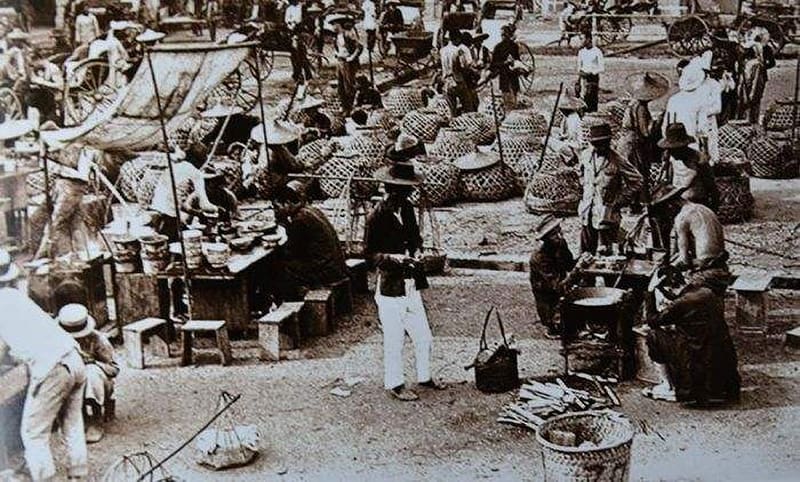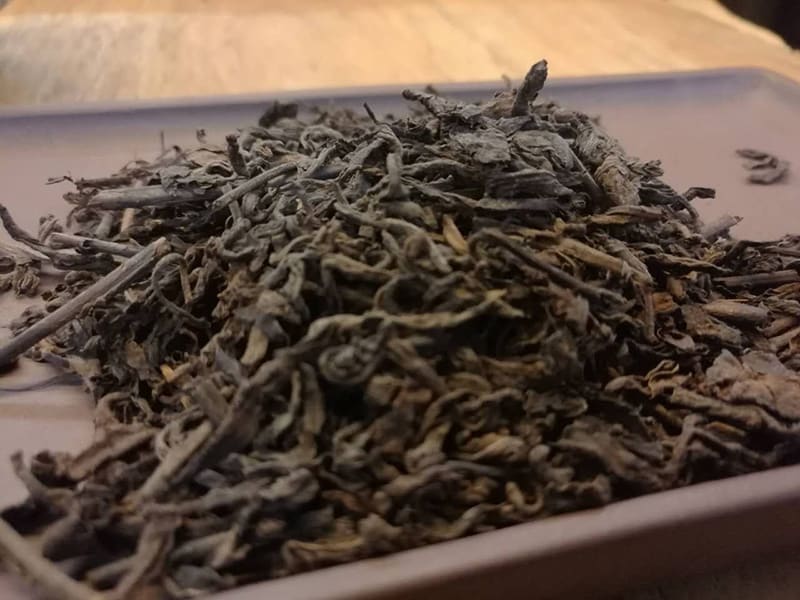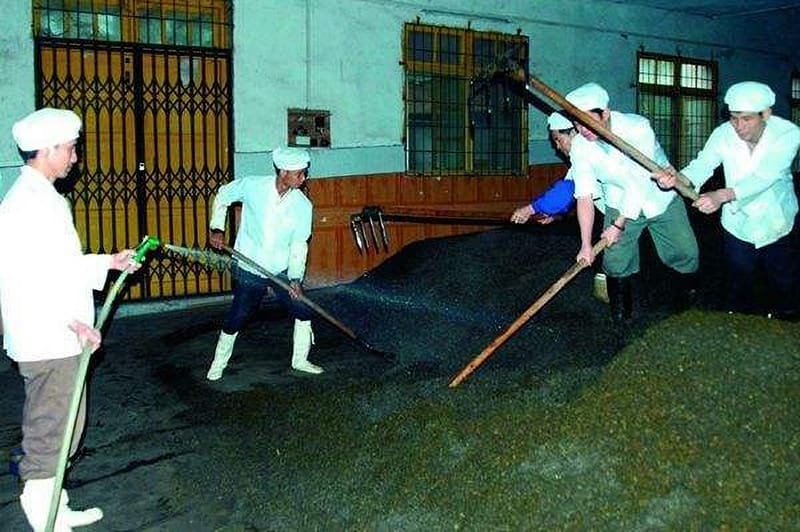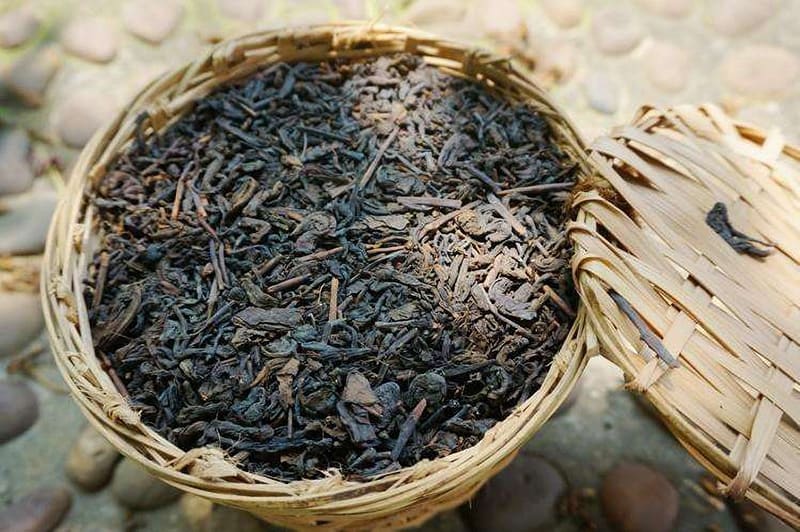Last Updated on 08/16/2020 by Desmond
Guangxi is a famous resort in China. Even though the modernization is relatively backward, but the natural environment has retained. In the ancient forest, some tea trees grew more than hundreds of years. Here, there is a popular dark tea – Liu Bao tea. This tea is said great benefits to the human body. In the past, Liu Bao tea is loved by people because of its medicinal properties.

CONTENT
What Is Liu Bao Tea
Liu Bao tea(or cha) originated in Wuzhou City, Guangxi Province. The annual average temperature here is 21.2℃, precipitation about 1500mm, mountains by mountains, which is suitable for various plants growing. In the Ming Dynasty(1368 to 1644), here were set numbers 1 to 6 villages by administrative division, and name with Bao(means fort.) Among them, the number 6 fort produced the best quality tea, so all the tea from here called Liu(6) Bao tea.
Liu Bao tea belongs to the post-fermented dark tea. Most of the time, tea masters will compress them into tea cakes for sale, and a small amount will sell in loose tea way. Teacakes are more convenient for aging and transport, and the longer time they aging, the better taste and high value will get.
In the Qing Dynasty(1644 to 1912), tea drinking is prevalent in folk, especially in Guangdong, the city near Guangxi. Liu Bao tea tastes awesome and can be brewed lots of rounds, so it loved by the Cantonese.
We know that Guangdong is the pivot of international trade and exchange of China. Therefore, Liu Bao tea became famous overseas gradually. At the beginning of the last century, rich tin ore was found in Malaysia, many Cantonese came there for work as miners. But the local climate was humid and hot, plus not acclimatized. The health of Cantonese workers seems not very well; many of them suffered from diarrhea.

In Chinese Medicine, the humid climate will affect human health, lead to arthralgia, weakness, and dizziness. They called this disease dampness-heat. Besides the delicate taste, Liu Bao tea also has a benefit loved by people – dispelling the dampness. The Chinese worker found that take Liu Bao tea as a daily drink can cure the sick caused by dampness-heat. And, the familiar taste can immensely pacify their homesickness.
As a result, vast Liu Bao tea exported to Malaysia through a path called Ancient Tea-boat Road. Both the Chinese miners and the local Malaysians, all took Liu Bao tea drinking as a daily habit. Soon it became popular in Southeast Asian countries. Now many people in the Kuala Lumpur restaurant will order a cup of Tang tea, which is Liu Bao tea actually.
Even though Liu Bao tea has certain visibility, but limited to Southeast Asia. In the 1980s to 1990s, it even went through a period of decay, most tea plantation fell into disuse, and tea trees were felled. Until the new century came, the Pu-erh tea became a trend, as a kind of dark tea, Liu Bao tea popular again too. Now, most tea trees in the plantations are new grew in recent years.
Fortunately, a few tea trees which several hundred years old were preserved, but the yield is low. So the local tea farmers typically not distinguish between the fresh leaves from the old trees and new trees, but collect them together for processing.
Moreover, the local tea plants are not in the same variety; some are middle leaves, and some are big leaves. That means the best picking time of them is different, the tea farmers have to pick at different times. It increases the labor and time costs.
Liu Bao Raw Tea & Liu Bao Ripe Tea
Just like Pu-erh tea, Liu Bao tea also exists in two styles: Liu Bao raw tea and Liu Bao ripe tea. The raw tea also called farm tea, produced by the local farmhouse, from picking to processing all in the traditional way. Liu Bao raw tea has not been piling(pile-fermented), just like the Pu-erh raw tea, so their flavor is close. It tastes like green tea, but stronger, the tea infusion shows dark yellow.
Raw tea contains lots of tea polyphenols, so taste bitter, many people do not like it. Of course, after a long time of aging, the taste of Liu Bao raw tea will change because of the internal ingredients transition and fermented. Become mellow, and lost the herbaceous flavor. But this typically costs more than five years. In fact, tea lovers usually not drink new raw tea; they prefer to store them for aging work.

Liu Bao ripe tea also called factory tea, standardization, and volume produced by the local tea factories. In the past time, Liu Bao tea all sold in the raw tea style. After the founding of New China, the tea factory adopted the new piling technology – ” twice steaming and compressing ” and “cold-water piling.” Due to this, the aging time of Liu Bao tea is significantly shortened, so called it ripe tea.
The whole piling processing costs dozens of days. And the unique flavor and fragrance of ripe tea were created during this period. The only problem is, this process has a high demand for the tea master. Because it is actually to create a high-temperature environment for microorganisms to do the fermentation work better. Ever a tea master made a mistake while watching, lead to a dozen tons of tea piling fail, the tea factory lost much money.
How Liu Bao Tea Processing
In ancient times, most Chinese teas were processing similar to the green tea(see how green tea processing.) The productivity was backward at that time, tea leaves can not always be dry in time. Tea masters would put them into a pile in the corner of the room, waiting to dry them the next day; thus, these piles of tea began to ferment.
People found the tea after piling taste softer, and few bitter, so they retained this step in the processing. This step operates like the sealing-yellow job of yellow tea, but much different in the humidity, temperature, and duration. Fixation – Rolling – Piling – Re-rolling – Drying is the earliest Liu Bao tea processing way; the farm tea is also the same.
Liu Bao raw tea must take a long time aging(typically 5-10 years) to create a new totally different taste. Tea masters thinking about how to cut down the time cost all the time. In 1958, the local tea masters learned the ” twice steaming and compressing ” and “cold-water piling” technology, for Liu Bao tea processing. These two methods will significantly reduce the aging time and not affect the original quality of tea.
“Twice steaming and compressing,” also called hot-fermented, it came earlier. Put the tea leaves after re-rolling in a large bamboo basket, heating them with hot steam, making them soft, and then compressing them. After about 24 hours, break them into pieces, steaming them again, then compress them into a cake, brick, or other shapes, finally drying.
“Cold-water piling,” also called cold-fermented, came rather late, but the effect is better than “twice steaming and compressing.” Tea masters put the tea leaves after re-rolling in piles, spray cold water on them and add some zymophyte. The cold-water piling typically costs more than a month, needs a veteran tea master watching at side, stir and add water according to the tea leaves status.

The artificial aging makes Liu Bao rough tea into ripe tea. The infusion change from dark yellow to bright red, and almost removes the bitter taste. People don’t need to spend a long time on the aging job anymore.
Nowadays, each manufacturer has a little different on the processing, not unified. Most of them adopt the cold-water piling method to increase ferment speed, then take steaming and compressing, finally make into a tea cake for sale.
Liu Bao Tea Flavor Types
Long ago, in the Qing Dynasty, Liu Bao tea relies on its unique areca-nut flavor won the prise off one of the 24 Chinese famous tea. About this unique flavor, many tea experts have different comprehension. But what is no doubt, this flavor only comes from the Liu Bao tea, which has been years aging. The charm of dark tea lies in you will get a different taste every time you brew it, even though the same tea cake.
Except for the areca-nut flavor, some Liu Bao tea will also create a smoky flavor. It’s not the same as the smoky flavor of Lapsang Souchong, it is not got by pine-smoke, but a natural transition. So compared with Lapsang Souchong, smoky-flavor Liu Bao tea tastes softer. Of course, some tea masters will take this as a selling point and make a cheat, drying with pine fire to get the smell.
Whether the areca-nut or smoky flavor only comes from the Liu Bao raw tea, the ripe tea can not get. To Liu Bao ripe tea, it has been certain fermented and aging before sales, so the flavor more similar to the wood. Of course, the ripe tea also can keep going aging, to get more abundant flavors. It is widely believed, that the Liu Bao ripe tea after a long time aging, will get herbal medicine flavor, or something tastes like ginseng.
The Unique Benefits
We mentioned a disease called dampness-heat in traditional Chinese medicine, and the most significant benefit of Liu Bao tea is the damp dispelling effect. The symptoms of dampness-heat similar to endocrine dyscrasia, the patient will felt weakness, inappetence, fidgets, even got many acnes.
In fact, it is not a severe disease, just a moment of physical discomfort, you do not need to treat it, and it will self-healing by time. But during the ill period, you will feel very uncomfortable.
The disease typically caused by two reasons. One is to eat and drink too much, especially hot food. Another reason is influence by the environment; people living in a humid and hot climate place, like Southeast Asia, will easy to get it.
People against the disease usually through dietary therapy. In China, people living in a humid climate will eat pepper, the very hot ones, to dispel the damp in the body by sweating. In most places, where the climate is less humid, people treat the disease by drinking some herbal tea or true tea.

According to modern medical research on Liu Bao tea, its treatment on dampness-heat mainly comes from two ways:
- The tea polyphenol in tea can help vasodilation and improve circulation, resulting in accelerating the body detoxification.
- Adjust the intestinal flora, improve the growth of the beneficial bacterium like bifidobacterium and lactic acid bacteria. Good digestion makes a better appetite.
Besides that, Liu Bao tea belongs to dark tea, which has an excellent effect on losing weight like green tea. Different from other types of tea, Liu Bao tea is rich in theabrownin, it does not taste bitter like the tea polyphenol, and has an outstanding effect on lipolysis, which can effectively reduce cholesterol and triglyceride in the body.
It is worth saying that some Liu Bao tea after aging will grow a few little golden flowers. These little golden flowers are Eurotium cristatum, which can secretion multiple enzymes, increase the ingredients in tea transition speed, form more flavor and benefits. Most of the cases, it appears in the Anhua dark tea, less in the Liu Bao tea case. Some manufacturers will artificially add them into the tea for better selling.
Liu Bao Tea Aging Tips
Aging means a lot to dark tea. After you bring a Liu Bao tea cake back, whether raw or ripe, the right storing way can help them better aging, and get a better taste.

Different from other types of tea on storing, the purpose of Liu Bao tea storing is for fermenting and transition, not retain freshness. A low airtightness container may be more suitable. Because of the microorganisms in tea need enough oxygen to keep activity, to do a better job on the ingredients transition. So a ceramic or bamboo tea container may be a good choice.
Related Reading: How To Choose Storage Container For Your Tea.
Due to the low airtightness, tea may be affected with damp by the water in the air during storage, and make it go bad. You need to pack it well with a rice paper, no matter loose tea or tea cake. The rice paper has excellent water absorption performance; under a humid environment, it can significantly help protect the tea from being influenced by water. You’d better check the rice paper whether it has been wet at regular intervals and replace it on time.
About the temperature and humidity of the storage environment, you don’t need to adjust it purposely(such as artificially humidification and warming); just let it nature. And about the storage place choose is like most type of tea, dark, dry, and scentless. Liu Bao tea needs one more condition – ventilation. That doesn’t mean let you store it at a strong-wind place, a long time blowing will take the scent of tea away, and makes it lost value.